Intel X25-V in RAID-0: Faster than X25-M G2 for $250?
by Anand Lal Shimpi on March 29, 2010 8:59 PM ESTMissing TRIM - Does it Matter?
Clearly the performance of two X25-Vs in RAID 0 is great, but you do lose TRIM - isn't that a dealbreaker? Honestly, it depends. For sequential accesses, TRIM isn't necessary on the Intel drives. The X25 controller does a good job of aggressively cleaning and recycling NAND blocks and you'll pretty consistently write at peak performance if your workload is almost all sequential.
The more random your access pattern is, the more you'll miss TRIM. Thankfully desktops don't spend too much of their time randomly writing data across the drive, but I'd say a good 30% of most desktop writes are random to an extent. Over time, these random writes will build up and bring down the overall performance of your RAID array until you either secure erase the drives or write sequentially to all available free space.
There is one other option for curbing the performance degradation before it happens. Remember the relationship between spare area and write amplification:
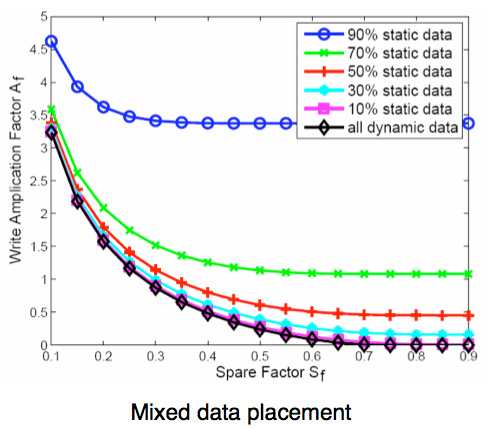
The more random your workload, the higher your write amplification (and thus the lower your performance, shorter your NAND lifespan). Increasing spare area can go a long way to reducing write amplification. While it can't eliminate it, it can definitely make a dent.
If you're looking to keep performance as high as possible with a pair of X25-Vs in RAID, you can always allocate more NAND as spare area. Secure erase each drive, create your RAID array, and then create your partition on the drive smaller than max capacity (try 10 - 20% smaller). The unpartitioned space should automatically be used by the controller as spare area. To test the effectiveness of this approach I took an X25-V, filled it with garbage data, and then wrote random data across the drive as fast as possible for 20 minutes. I then ran HD Tach to get a visualization of write latency (expressed by sudden drops in bandwidth) vs. LBA:
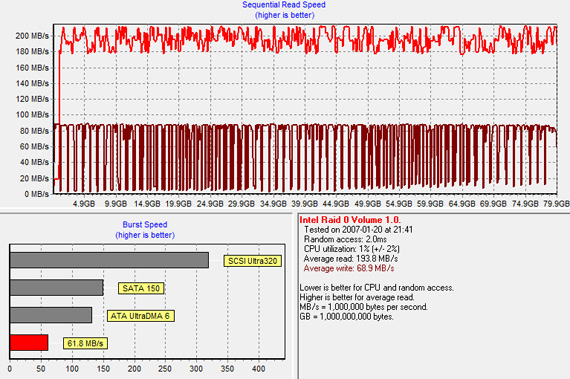
A standard 80GB X25-M wouldn't be this bad off, the X25-V gets extra penalized by having such a limited capacity to begin with. You can see that the drive is attempting to write at full speed but gets brought down to nearly 0MB/s as it has to constantly clean dirty blocks. Constant TRIMing would never let the drive get into this state. It's worth mentioning that a desktop usage pattern shouldn't get this happen either. Another set of sequential writes will clean up most of this though:
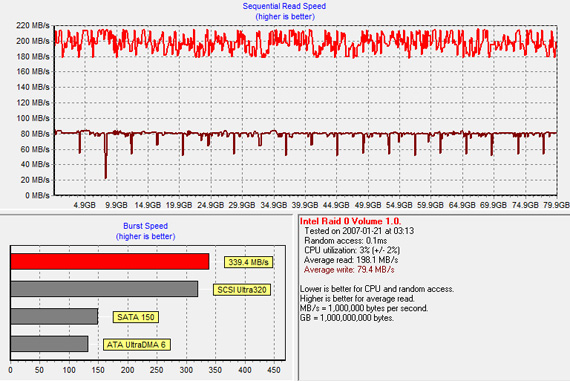
Intel's controller is very resillient. Even without TRIM, as long as your access pattern has some amount of a sequential component you'll be able to eventually recover performance.
Now look at what happens if we only use 60GB of the 74.5GB RAID 0 array upon creation and run the same test:
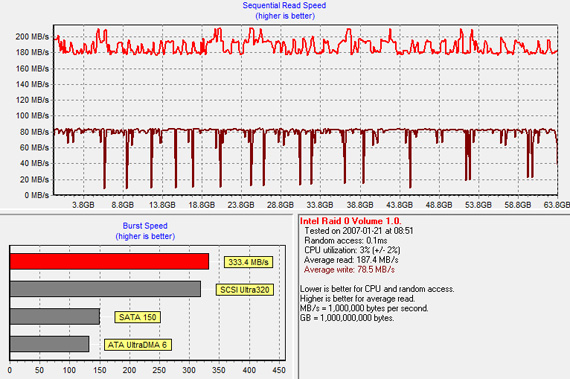
Performance isn't nearly as bad. That added spare area really comes in handy. Of course another pass corrects nearly everything:
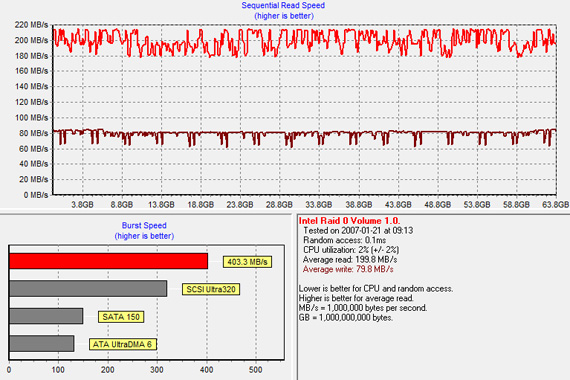
If you don't need the added space, using a smaller partition is a great way to ensure high performance for as long as possible. The effectiveness of this approach is a difficult thing to benchmark given that it's only after months of normal use that you get enough random writes to the drive to be a problem. The good news is that even if you bombard the X25-Vs with random writes, the drives can quickly recover as soon as they're hit with some sequential data.










87 Comments
View All Comments
IvanAndreevich - Tuesday, March 30, 2010 - link
I am sure they would blow these away, and at $80 AR they are cheaper per GB. They also support GC and TRIM with 1.5 firmware.machzero - Tuesday, March 30, 2010 - link
Ya missed an important point on the first page."1) There is currently no way to pass the TRIM instruction to a drive that is a member of a RAID array."
The drives may support TRIM but no RAID controller on the market will pass the instruction to the drive.
Minion4Hire - Tuesday, March 30, 2010 - link
And OCZ's garbage collection is entirely independent from the drive controller, and doesn't need instructions passed to it like TRIM. It will work regardless of your configuration.And on that note, I have two 60GB OCZ Agility SSDs in RAID 0 and am very happy with them. My sequential read performance sits at over 400MB/s and sequential writes are over 200MB/s. Although my random read and write performance isn't quite as nice as the Intels RAIDed here, I didn't pay any more for my drives ($140 ea. Canadian on sale after rebate) and have an extra 40GBs of storage over this Intel RAID. The extra capacity is what sold me on the OCZ drives over Intel, but I'd be willing to bet that the Intel X25-V drives would offer a better overall RAID experience than a set of Agilities, even with their lack of garbage collection as Anand noted.
funkyd99 - Wednesday, March 31, 2010 - link
Is the lack of TRIM a limitation of RAID controllers or a limitation in the drivers? I.e. could an update to the Intel storage drivers remedy the problem on Intel chipsets?plamengv - Friday, April 2, 2010 - link
There is no lack of TRIM for RAIDs anymore thanks to Intel.http://guru3d.com/news/intel-brings-trim-to-ssds-i...
nwrigley - Friday, April 2, 2010 - link
Nope, it only supports single drives running next to a RAID. RAID still lacks TRIM support.http://techreport.com/discussions.x/18653
Makaveli - Tuesday, March 30, 2010 - link
Performance is great, since I already have one 160GB G2 drive I would love to see a second in Raid 0..hint hint :)should be able to hit 200 mb/sec writes!!
TheHolyLancer - Tuesday, March 30, 2010 - link
I'm wondering, is there a way (be it a special raid card or something else) to allow me to to put put a raid 0 +1 array in there with standard hdds?Something like 2 SSDs + 2 hdds or hell 2 SSDs + 1 large hdd with 2 partitions. This way, you can get data protection on the cheap.
Or for something like this to work, the drive performance has to be big, or else you need a huge data cache on the controller in order for the hdds to catch up to SSDs.
Or is this just completely outside the scope of what current controllers can do?
Calin - Tuesday, March 30, 2010 - link
You don't have that option (and anyway, it will slow your RAID to the speed of the slowest writing disk, even if reads will always take place from the SSD drives).therealnickdanger - Tuesday, March 30, 2010 - link
You're better off creating a SSD RAID-0 as your boot/app/game drive and then back up that partition every night (or twice per day?) to a HDD RAID-1/5/6. It's not as protected as a real-time RAID-1/5/6, but it's the best and cheapest of both worlds. Also, if you've ever tried to restore a RAID-1/5/6, it takes much, MUCH longer than restoring a partition from a backup. I use Windows Home Server to do this for my ~60GB SSD partition and it is bloody quick (the one time I had to do it).